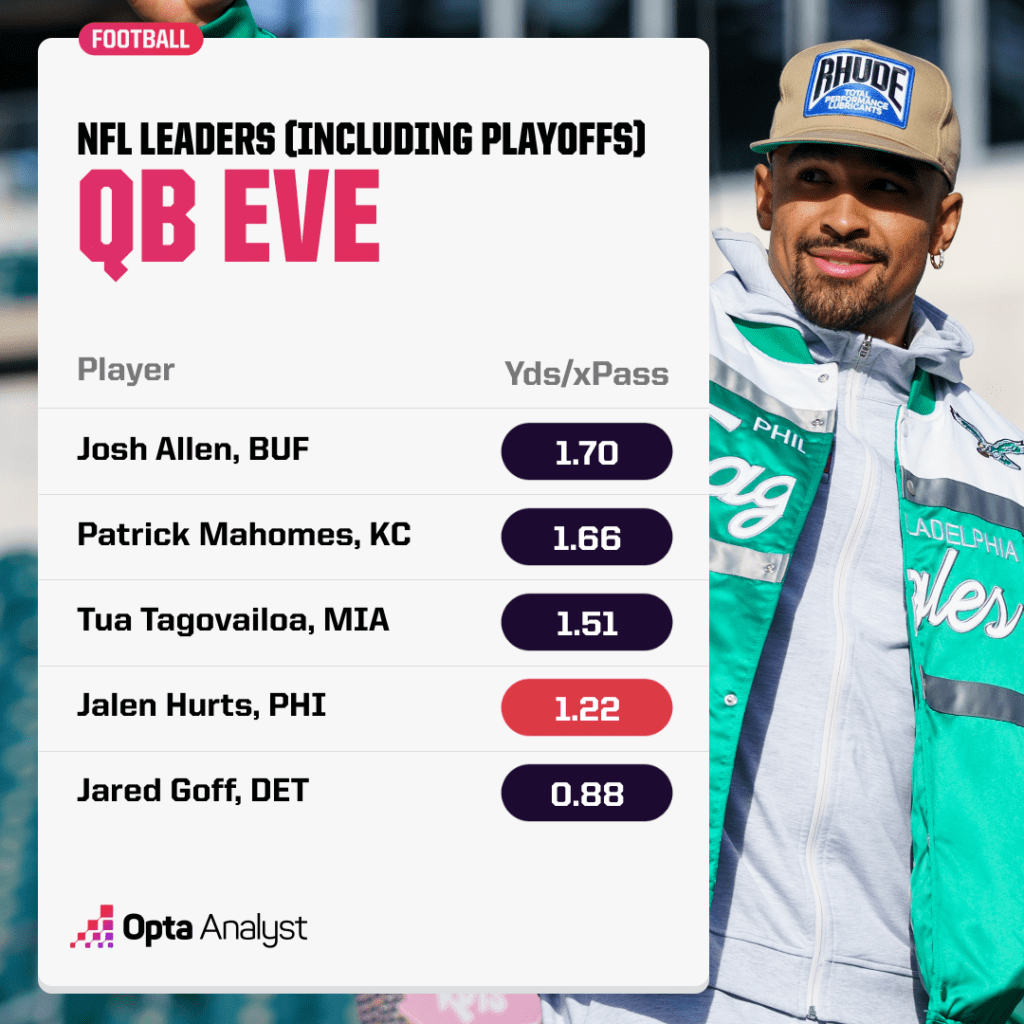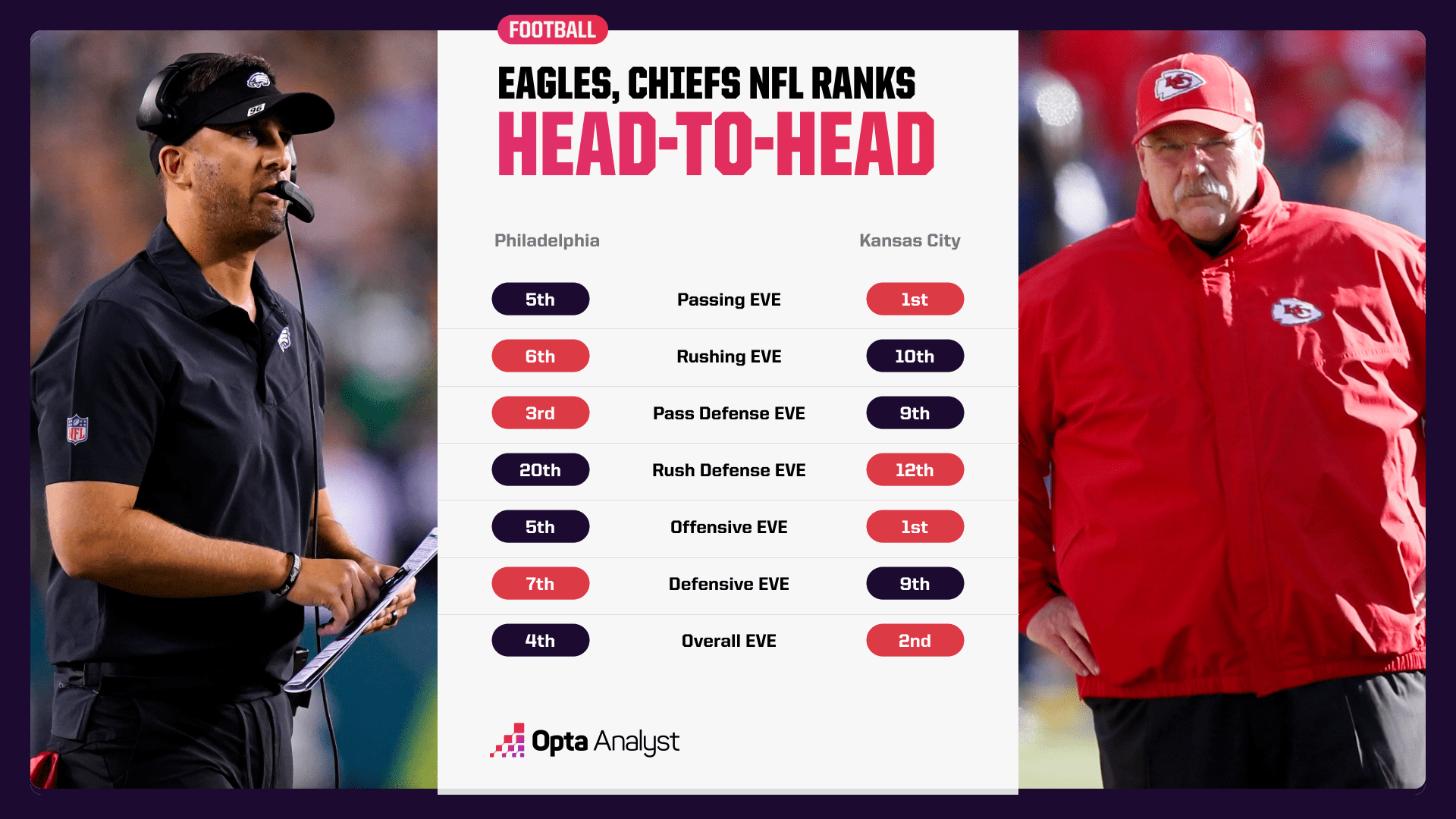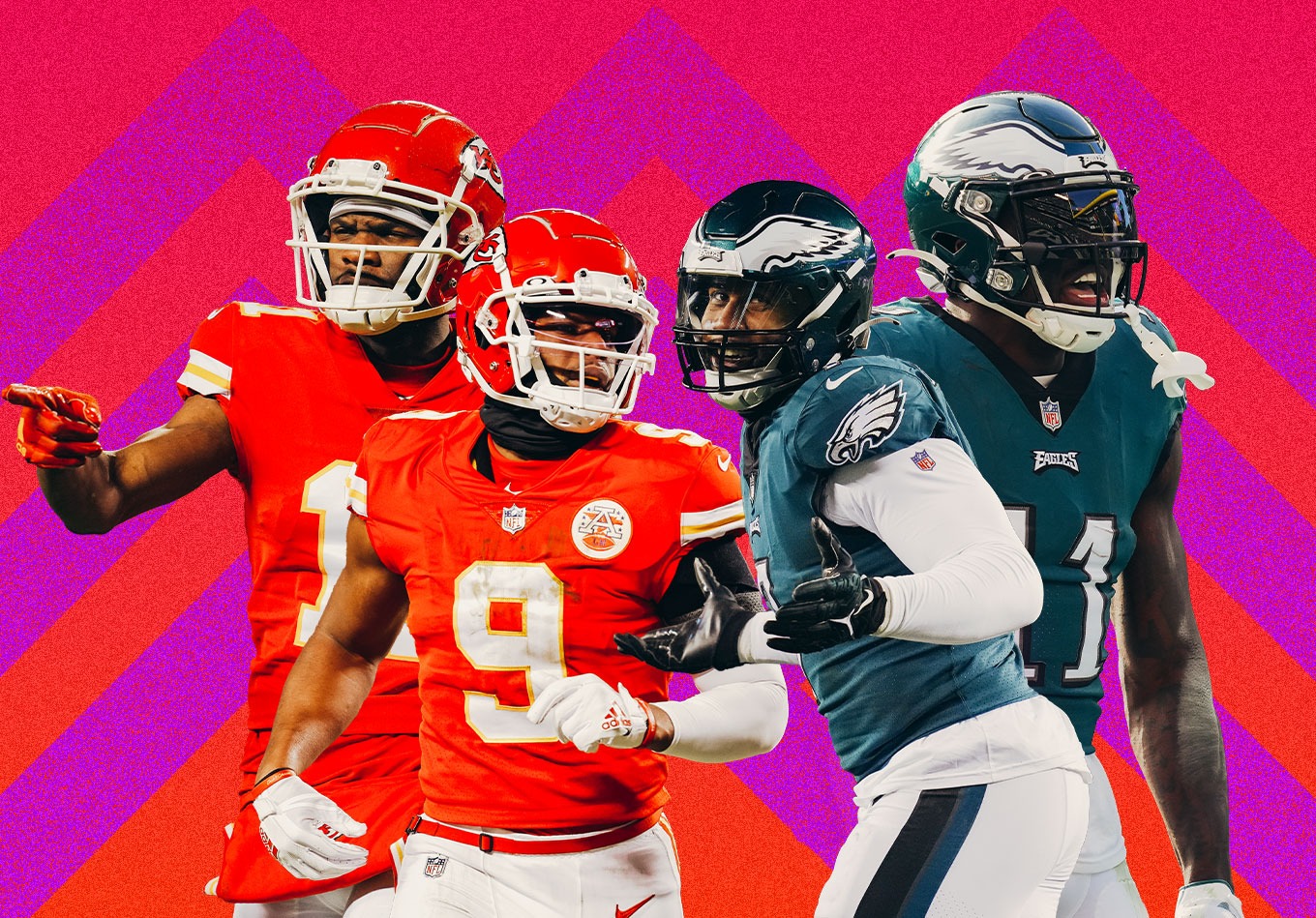If the Super Bowl LVII matchup between the Kansas City Chiefs and Philadelphia Eagles is proof of anything, it’s that teams can win their conference no matter how much they’re paying their starting quarterback.
It’s the single greatest disparity between the Chiefs and Eagles from a team-building perspective ahead of Sunday’s Super Bowl.
Patrick Mahomes signed a record 10-year, $450 million contract extension three years ago and had a cap hit of $35.8 million in 2022, which took up 17% of Kansas City’s salary cap this season.
Jalen Hurts, meanwhile, is still in the midst of his four-year, $6.025 million rookie contract he signed as a second-round pick out of Oklahoma in 2020. He had a $1.6 million cap hit in 2022, which accounted for just 0.7% of Philadelphia’s salary cap.
There’s a case to be made that Hurts was the single greatest value in the NFL this season from a contract perspective. The starting quarterback took up less than 1% of the salary cap space and ranks fourth in passing EVE (yards gained over expected in anticipated passing situations) heading into Super Sunday.

And obviously, those contracts affected how each team could spend last offseason. But before we get into that, it’s obvious that Hurts will be signing a contract extension soon. That deal will likely take place this offseason unless the Eagles plan to let his deal expire and franchise-tag him in the future.
But Mahomes also will likely need an adjustment soon as well. He signed his deal on July 6, 2020, and at its peak, he’ll take up $59.95 million in salary cap space in 2027. The Chiefs obviously won’t want to do this, but there are ways out of his contract before that time. But he’s 27 years old, the best quarterback in the NFL, and he’s currently being paid less than Aaron Rodgers ($50.3M), Russell Wilson ($49M), Kyler Murray ($46.1M) and Deshaun Watson ($46M) on an APY basis.
Lamar Jackson, Joe Burrow, Justin Herbert and Hurts, as well as Tua Tagovailoa, all are eligible to sign contract extensions and could also exceed $45 million per year this offseason. In 2023, Mahomes’ $46.8 million cap hit will rank below Watson and Dak Prescott. His cash value of $40.45 million will rank below Rodgers and Watson. Mahomes should perpetually be the highest-paid quarterback in the NFL, and it wouldn’t come as a major shock if the Chiefs corrected his contract value by tacking on a few more millions sooner than later.
Hurts is currently set to have a $4.8 million cap hit in 2023, which ranks 28th among quarterbacks. His cash value of $4.3 million ranks 21st. Hurts’ cap hit will rise in 2023 if he signs a contract extension, but it won’t need to increase significantly until 2024 and beyond. Murray signed a five-year, $230.5 million contract extension last offseason, and Hurts was inarguably a better player in 2022. It’s not out of the realm of possibility that he could sign a deal that matches or exceeds Murray’s contract, especially since the salary cap is rising.
So while the Eagles were able to spend freely in 2022, they will need to curb some of their moves once Hurts is making big money and off of his rookie contract. Still, they’re currently set to have over $4 million in cap space next season, $47.5 million in 2024 and over $150 million in 2025 and beyond.
And Hurts’ contract did give the Eagles a ton of flexibility last offseason.
They were able to re-sign center Jason Kelce (one year, $14 million) and defensive end Derek Barnett (two years, $14 million). They also cut then re-signed defensive lineman Fletcher Cox to a one-year, $14 million deal and boosted their defensive firepower by signing edge defender Haason Reddick (three years, $45 million), cornerback James Bradberry (one year, $10 million) and linebacker Kyzir White (one year, $5 million).
Their most important addition came by way of trading for wide receiver A.J. Brown and signing him to a four-year, $100 million contract extension. Philadelphia also traded for edge defender Robert Quinn and safety C.J. Gardner-Johnson. Late in the season, the Eagles were able to sign defensive linemen Ndamukong Suh and Linval Joseph to shore up their run defense.
Through the use of backloaded deals and void years by savvy general manager Howie Roseman, those additions only added up to about $35.6 million in 2022 salary-cap hits. But because Hurts is on a rookie deal and won’t cost a significant amount against the cap for a couple of years, the Eagles were able to go “all in” this season. Unlike a team like the Los Angeles Rams, they were able to maintain draft picks (they own the New Orleans Saints’ No. 10 overall pick) and not get into salary-cap hell in the future.

The Chiefs have shown that a team can still make the Super Bowl after paying their quarterback a top-of-market deal. Paying quarterbacks is not a bad thing. It’s a must to keep an elite player under contract. Sometimes it backfires. The Eagles know all about that when they signed Carson Wentz to a four-year, $128 million deal in 2019, but then they had the foresight to draft Hurts in the second round the next year.
The best window for a team is when its quarterback is cheap and on a rookie deal. But if the quarterback is worth a top-of-market deal, then a team simply has to keep him on board. Some concessions have to be made when finally locking a quarterback into a big contract, however.
Most notably, the Chiefs traded away wide receiver Tyreek Hill last offseason when he wanted a new contract, which he received from the Miami Dolphins in the form of a four-year, $120 million extension. Hill was set to count for $21.9 million on the Chiefs’ 2022 salary cap. They freed up most of that money by trading him to the Dolphins. Hill counted just $6.485 million against the Dolphins’ salary cap this season after signing his extension, but that figure rises to $31.45 million next season.
Kansas City was still able to make moves in the offseason. It franchise-tagged left tackle Orlando Brown ($16.662M), signed wide receivers Marquez Valdes-Scantling (three years, $30M) and JuJu Smith-Schuster (one year, $3.76M), safety Justin Reid (three years, $31.5M) and edge defender Carlos Dunlap (one year, $3M) and brought back defensive tackle Derrick Nnadi (one year, $2.75M) and offensive tackle Andrew Wylie (one year, $2.5375). Those players cost over $36 million against the cap in 2022, but Brown accounted for 46% of that figure, and general manager Brett Veach doesn’t use the same void-year tricks as Roseman.
The Chiefs lost cornerbacks Mike Hughes and Charvarius Ward, center Austin Blythe, safety Tyrann Mathieu, edge defender Melvin Ingram, wide receiver Byron Pringle and defensive lineman Jarran Reed in free agency but still traded for Kadarius Toney before the 2022 trade deadline. The most significant player the Eagles lost in free agency was cornerback Steven Nelson.
It helps that every high-profile player the Eagles added was a hit and that they’ve drafted very well over the years. But they won’t be able to spend quite as freely once Hurts is in the middle of a contract extension and they’ll need to make the same difficult decisions the Chiefs did last offseason.
The Chiefs had to be more frugal because they have Mahomes on a high-priced contract extension, despite the fact that it does indeed look like a bargain at this point. Their defense, for example, while still good enough this season to be ranked ninth in overall EVE and ninth in EVE against the pass, would have been better with Ward at cornerback.
It’s also worth noting that by trading away Hill and not signing him to a high-priced extension, the Chiefs are still in decent salary-cap shape moving forward. They have $14 million in cap space heading into this offseason, and more than $100 million for 2024 and beyond. And they were still able to make a Super Bowl by replacing Hill with Valdes-Scantling, Smith-Shuster, Toney, Justin Watson and Skyy Moore, and their pass-catchers led the league in burn percentage and open percentage while the team was first in passing success rate.
The Chiefs’ salary cap was more top-heavy. They had four players with cap hits that took up more than 6.0% of their cap, while the Eagles had just one. Meanwhile, the Chiefs had just nine players who took up more than 1.6% of their salary cap, while the Eagles had 14 on their roster. And both teams are in the Super Bowl, which is really all that matters.
